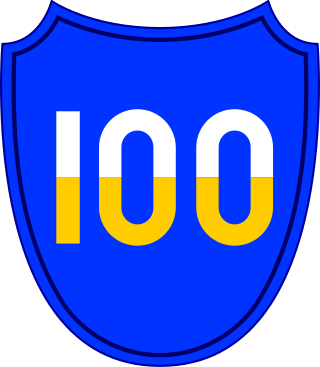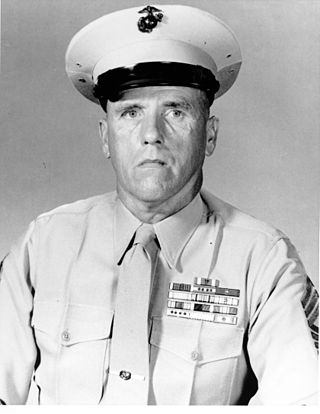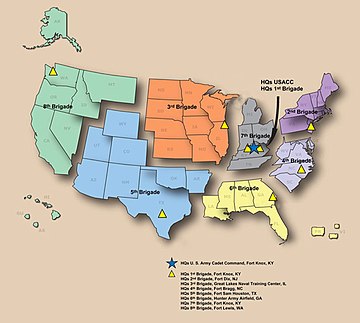
The Army of Northern Virginia was the primary military force of the Confederate States of America in the Eastern Theater of the American Civil War. It was also the primary command structure of the Department of Northern Virginia. It was most often arrayed against the Union Army of the Potomac.

The 78th Training Division (Operations) ("Lightning") is a unit of the United States Army which served in World War I and World War II as the 78th Infantry Division, and currently trains and evaluates units of the United States Army Reserve for deployment.

The 100th Training Division (Leader Development) (formerly the 100th Infantry Division) is a division of the United States Army headquartered at Fort Knox, Kentucky. It currently serves as a major training command of the United States Army Reserve. It has been known as the "Century Division" owing to its "100th" designation.

The United States Army Reserve (USAR) is a reserve force of the United States Army. Together, the Army Reserve and the Army National Guard constitute the Army element of the reserve components of the United States Armed Forces.

The Air Force Reserve Officers' Training Corps (AFROTC) is one of the three primary commissioning sources for officers in the United States Air Force and United States Space Force, the other two being the United States Air Force Academy (USAFA) and Air Force Officer Training School (OTS). A subordinate command of the Air University within the Air Education and Training Command (AETC), AFROTC is aligned under the Jeanne M. Holm Center for Officer Accessions and Citizen Development at Maxwell AFB, Alabama. The Holm Center, formerly known as the Air Force Officer Accession and Training Schools (AFOATS), retains direct responsibility for both AFROTC and OTS.

The National Society of Pershing Rifles is a military-oriented honor society for college-level students founded in 1894 as a drill unit at the University of Nebraska–Lincoln. It is the oldest continuously operating US college organization dedicated to military drill. Originally named Varsity Rifles, members renamed the organization in honor of their mentor and patron, Lieutenant John J. Pershing, upon his departure from the university in 1895.

James Johnston Pettigrew was an American author, lawyer, and soldier. He served in the army of the Confederate States of America, fighting in the 1862 Peninsula Campaign and played a prominent role in the Battle of Gettysburg. Despite starting the Gettysburg Campaign commanding a brigade, Pettigrew took over command of his division after the division's original commander, Henry Heth, was wounded. In this role, Pettigrew was one of three division commanders in the disastrous assault known as Pickett's Charge on the final day of Gettysburg. He was wounded, in the right hand, during the Pickett-Pettigrew Charge on July 3, 1863 and was later mortally wounded during the Union Confederate rearguard action while the Confederates retreated to Virginia near Falling Waters, Virginia on July 14, dying several days thereafter on July 17, 1863.

Thomas J. McHugh was a United States Marine who served as the 3rd Sergeant Major of the Marine Corps from June 29, 1962, to July 16, 1965.

The United States Army Forces Command (FORSCOM) is the largest United States Army command. It provides expeditionary, regionally engaged, campaign-capable land forces to combatant commanders. Headquartered at Fort Liberty, North Carolina, FORSCOM consists of more than 750,000 active Army, U.S. Army Reserve, and Army National Guard soldiers. FORSCOM was created on 1 July 1973 from the former Continental Army Command (CONARC), who in turn supplanted Army Field Forces and Army Ground Forces.

John William Harrelson was the sixth chief executive of North Carolina State College from 1934 to 1953. An artillery officer in the U.S. Army Reserve, he was the first N.C. State alumnus to lead the institution and the first leader of the university to hold the title of Chancellor.
The United States Army Regimental System (USARS) is an organizational and classification system used by the United States Army. It was established in 1981 to replace the Combat Arms Regimental System (CARS) to provide each soldier with continuous identification with a single regiment, and to increase a soldier's probability of serving recurring assignments with his or her regiment. The USARS was intended to enhance combat effectiveness by providing the opportunity for a regimental affiliation, thus obtaining some of the benefits of the traditional regimental system.
In the United States, a senior military college (SMC) is one of six colleges that offer military Reserve Officers' Training Corps (ROTC) programs under 10 U.S.C. § 2111a(f), though many other schools offer military Reserve Officers' Training Corps under other sections of the law. The six senior military colleges are:
A corps of cadets, also called cadet corps, is a type of military school intended to prepare cadets for a military life, with the school typically incorporating real military structure and ranks within their respective program.

The 6th Reserve Officers' Training Corps Brigade is an Army Reserve Officers' Training Corps brigade based at Hunter Army Airfield, Georgia. It provides training support and oversight to all Army ROTC and Junior ROTC units in the states of Alabama, Georgia, Florida, Louisiana, Mississippi, and Puerto Rico.

The 3rd Reserve Officers' Training Corps Brigade is an Army Reserve Officers' Training Corps brigade based at the Great Lakes Naval Training Center, Illinois. The Commander is COL Adam Lewis and the Command Sergeant Major is CSM Gareth Kilpatrick.

The 1st Reserve Officers' Training Corps Brigade is an Army Reserve Officers' Training Corps brigade based at the Fort Knox, Kentucky. This brigade is responsible for the 10 Senior Military Colleges and Military Junior Colleges.

The Army Reserve Officer Training Corps (AROTC) is the United States Army component of the Reserve Officers' Training Corps. It is the largest Reserve Officer Training Corps (ROTC) program which is a group of college and university-based officer training programs for training commissioned officers for the United States Army and its reserves components: the Army Reserves and the Army National Guard. There are over 30,000 Army ROTC cadets enrolled in 274 ROTC programs at major universities throughout the United States. These schools are categorized as Military Colleges (MC), Military Junior Colleges (MJC) and Civilian Colleges (CC).

Daniel Robert Hokanson is a four-star general in the United States Army who currently serves as the 29th chief of the National Guard Bureau. He previously served as the 21st director of the Army National Guard. His previous military assignments include serving as vice chief of the National Guard Bureau, deputy commander of United States Northern Command, adjutant general of the Oregon National Guard, and commander of the 41st Infantry Brigade Combat Team. He is a veteran of Operation Iraqi Freedom, Operation Enduring Freedom, and Operation Just Cause. Hokanson assumed his current assignment on 3 August 2020.

The 10th South Carolina Infantry Regiment was a Confederate volunteer infantry unit from the state of South Carolina during the American Civil War. It fought with the Army of Tennessee in the Western Theater for the duration of the war. Originally organized to serve for twelve months it was reorganized for the war in 1862. Sent east to fight in the Carolinas Campaign in 1865 it was consolidated with the 19th South Carolina Infantry Regiment and formed Walker's Battalion, South Carolina Infantry. The unit surrendered with General Joseph E. Johnston and the Army of Tennessee at Bennett Place on April 26, 1865. Out of 2189 men listed on the regimental muster rolls throughout the conflict only 55 enlisted men remained to be paroled.















